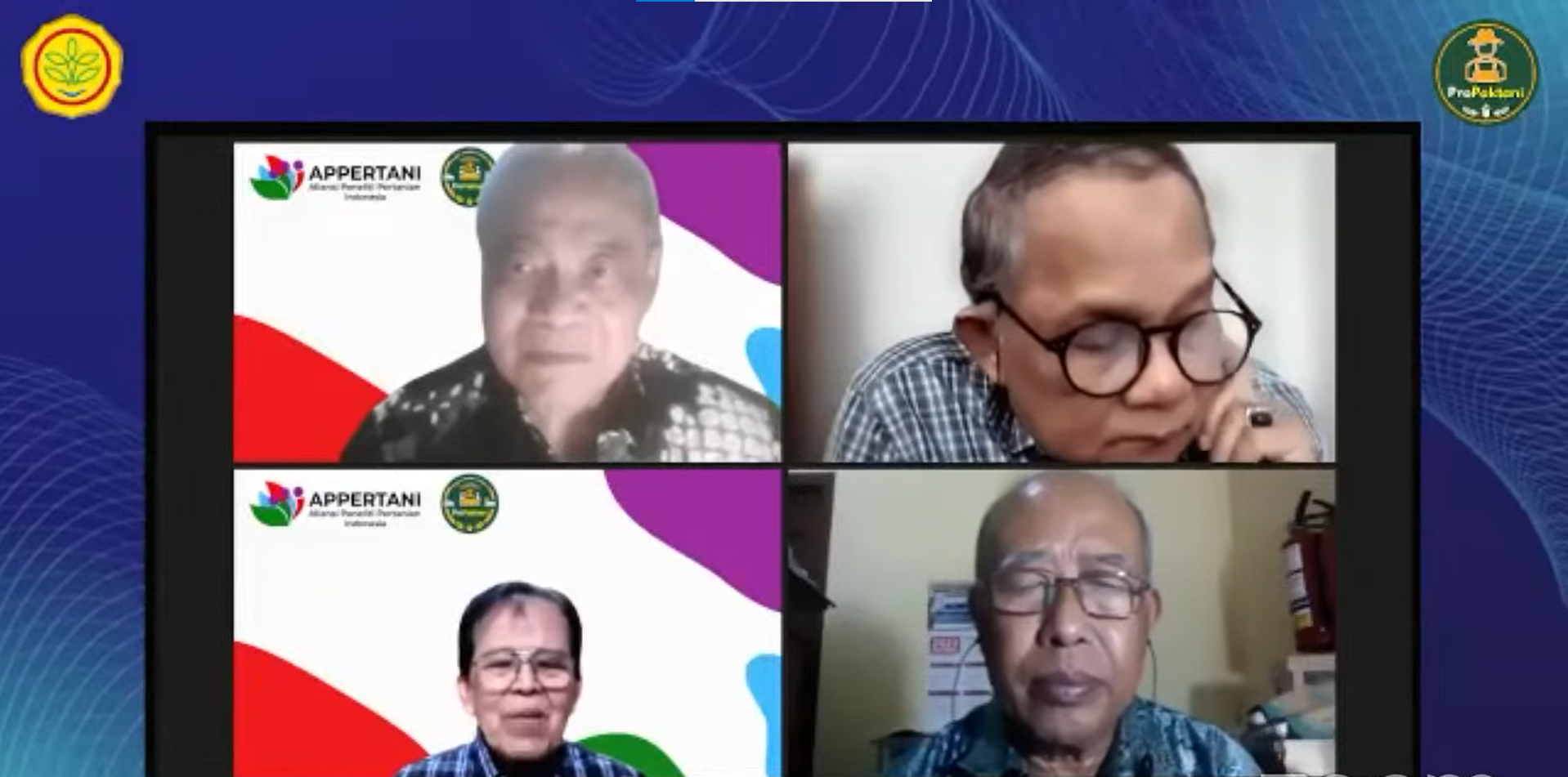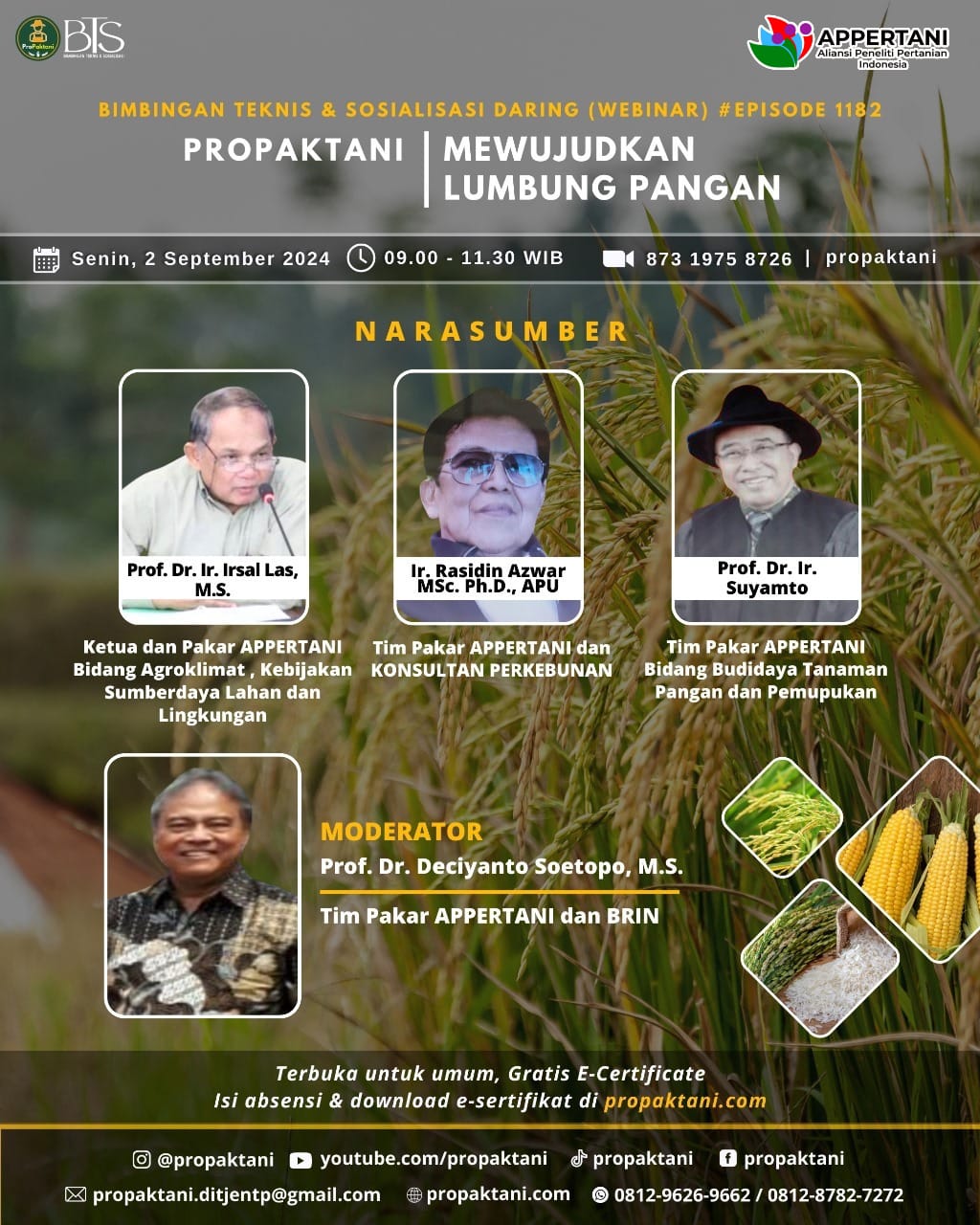Online Socialization and Technical Guidance (WEBINAR) #EPISODE 1182 PROPAKTANI

Realizing Food Estates
Several international media reported that there was a food shortage disaster to meet the food needs of the world’s population. Currently, it is reported that 44 countries are experiencing serious hunger. The population of Indonesia is estimated to be 7-16% still vulnerable to famine. The global agricultural challenge until 2050 must increase food production by 70%, grains by 43% and meat production by 70%. The Government of Indonesia is determined to build a sustainable modern agriculture that can usher in becoming the world’s food basket. Propaktani episode 1182 organized by APPERTANI discussed the topic: Realizing Food Estates, to meet the domestic food needs even more so that it can be accessed by the world community in the international food market. The moderator of this webinar episode was Prof. Dr. Deciyanto Soetopo, M.S., APPERTANI Expert Team in the Field of Food Crop Pests and Diseases and BRIN researchers.

Prof. Dr. Ir. Irsal Las, M.S., Chairman and Expert of APPERTANI for Agroclimatic, Land Resources and Environment Policy delivered the topic: “Realizing Indonesia into the World’s Food Estates: Is It Possible”. Indonesia is inseparable from the threat of a food crisis as seen from the trend of declining food production (rice) and increasing rice imports recently from 2023 until now. The Government has prepared a Grand Design of the World Food Basket (WFB) which is equipped with a Strategic Commodity Development Roadmap 2016-2045. The idea of achieving WFB has been started by the Ministry of Agriculture from efforts to realize land and food sovereignty, fllowed by Building Food Baaket on the country border, Successful Self-Sufficiency: Indonesia Becomes the World Food Estates 2045. The State Intelligence Agency of the Republic of Indonesia also prepared a plan for Strengthening Food Security: For the Future of Indonesia 2017-2030. IPB University also published Climate Change R&D Challenges at the Local and International Levels Towards Indonesia WFB 2045. IAARD, before the R&D function was integrated into BRIN, had published book series 500, 600 and 1000 innovative agricultural technologies. The basic and absolute prerequisites for realizing the WFB: 1) reorientation of regulations and policies, especially farming and fertilization; 2) optimal mechanization of agriculture; 3) reorientation of regulations and policies on water management (macro-micro); 4) awakening/encouraging millennials in the modern agricultural system/food estate, 5) industrialization of food agriculture.
Ir. Rasidin Azwar, M.Sc., Ph.D., APU APPERTANI Expert Team and Plantation Consultant delivered material with the topic: “Synchronization of Food Agriculture and Plantations: In order to realize the Indonesia of becoming the world’s food estates in the Golden Indonesia Era 2045“. Indonesia will resume rice imports in 2023 by 6 million tons because domestic rice production is only 31 million tons out of the need of 37 million tons. In 2024, it is estimated that imports will be 5 million more tons, although domestic rice production will increase to 1 million tons, but it is not enough to meet domestic rice needs. The domestic rice production deficit is caused by the decreasing area due to the conversion of land to non-agriculture and management by farmers with narrow plots of land with low productivity. Indonesia is very likely to realize a food estates in the future with a production target of 75 million t/year of rice and 50 million t/year of feed corn. Food basket can be realized in the form of corporate farming (CF) covering an area of 5 million ha because of modernizing traditional rice field management and the development of a modern Food Estate (FE) covering an area of 2 million ha by business entities. The construction of the new FE is carried out on Class 1 Rubber and Palm Oil Right of Use Land which can be started by converting old rubber and oil palm plantations left by foreign companies in the pre-independence era. Traditional rice fields covering an area of 7.5 million ha are transformed into CF with a feasible economic scale (medium holders) based on the expanse in accordance with full mechanization to an area of 5 million ha. The remaining 2.5 million ha can be used for other crops or viable economic activities.
Prof. Dr. Ir. Suyamto. APPERTANI Expert Team in the Field of Food Crop Cultivation and Fertilization delivered material with the topic: “Appropriate Technology Support to Realize Food Estates”.Food estates contain the meaning of increasing domestic production capacity to strengthen food security and independence, as well as to strengthen national food competitiveness, so that it is able to take advantage of export opportunities. The roadmap for the development of strategic commodities 2016-2045 has been prepared for various food commodities (rice, corn, soybeans, onions, chili, garlic, industrial sugar, consumer sugar, beef) in 2016. The scenario of achieving the WFB and the self-sufficiency time target to achieve the food basket in 2045 have been prepared. The strategy to realize WFB is to increase domestic production capacity to strengthen national food security and independence as well as increase surplus and strengthen national food competitiveness so that it can take advantage of food export opportunities to the global market in a sustainable manner. The strategy requires technological support for its implementation. Production capacity can be increased by clearing new land and increasing harvest index which must be followed by increasing facilities and infrastructure and human resource capacity. Increasing surplus and competitiveness requires the implementation of location-specific appropriate technology packages. Facilities and infrastructure support and human resource capacity building are urgently needed for the implementation of location-specific technology /precision technology. The preparation of the technology package with the selection of technology components is adjusted to the stages of plant management from pre-planting planning to harvest management. Basically, technology has been available and not all of it has been applied consistently and massively in the field and has received timely support as needed.

